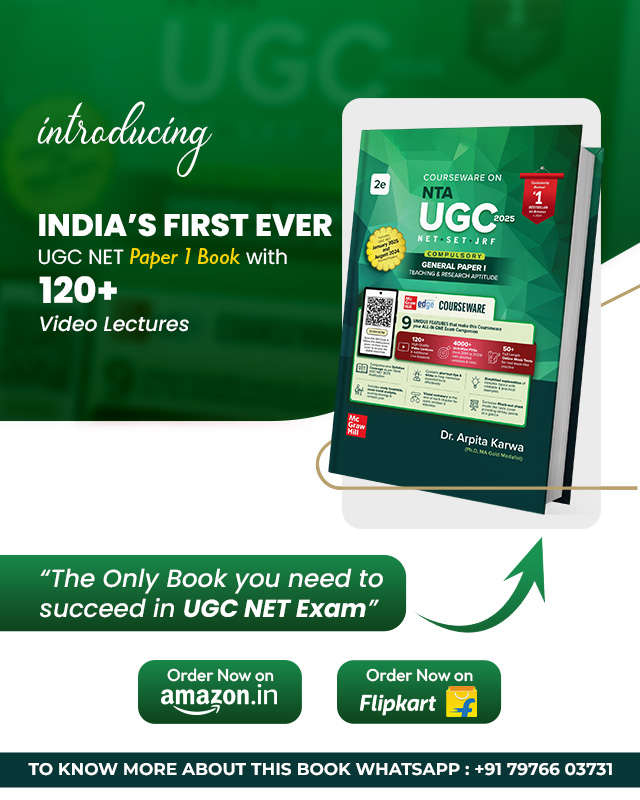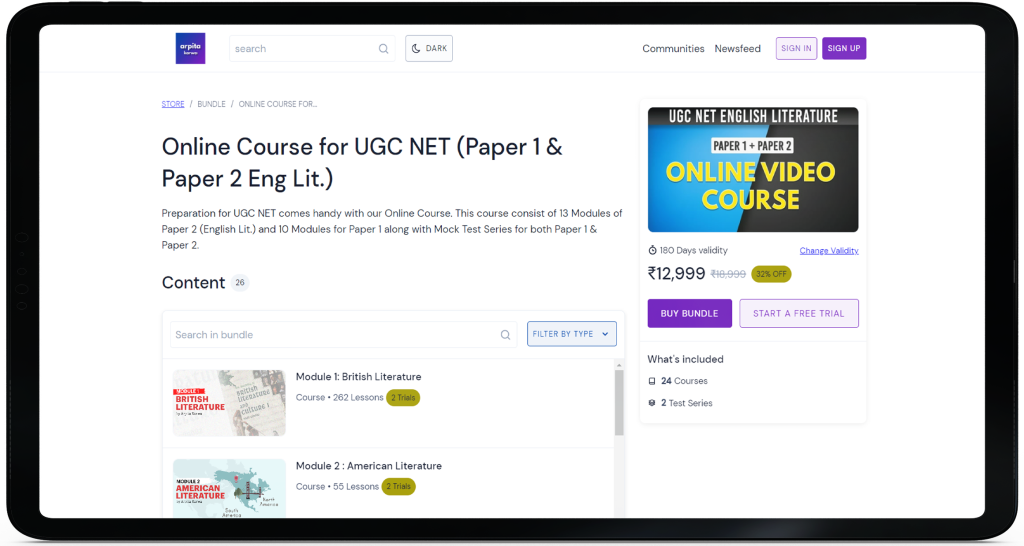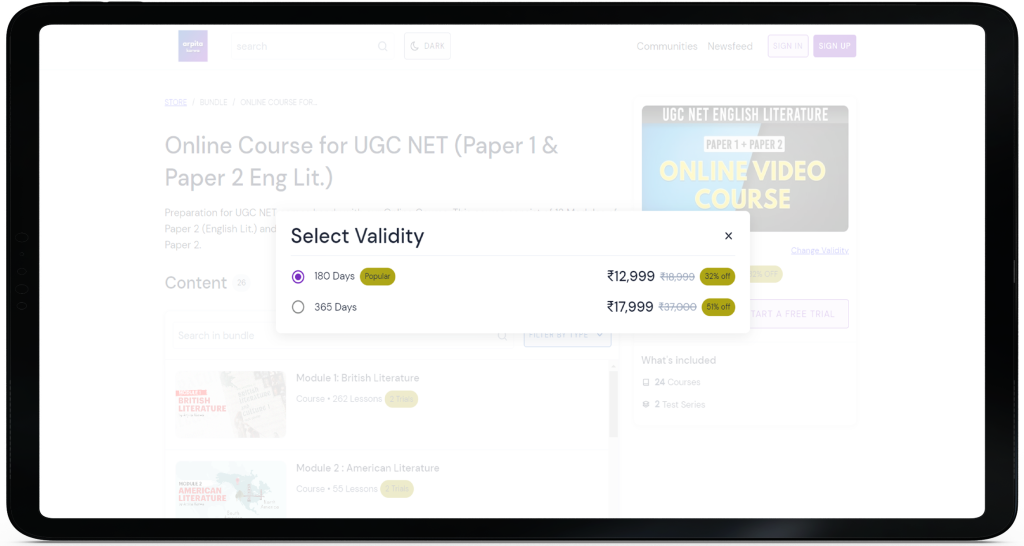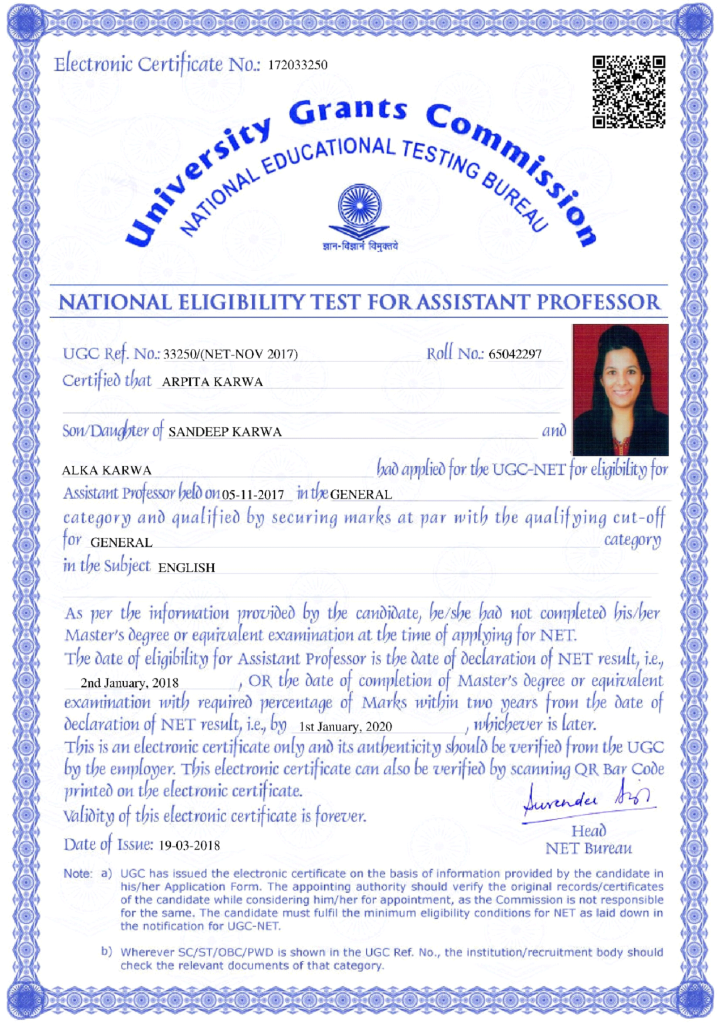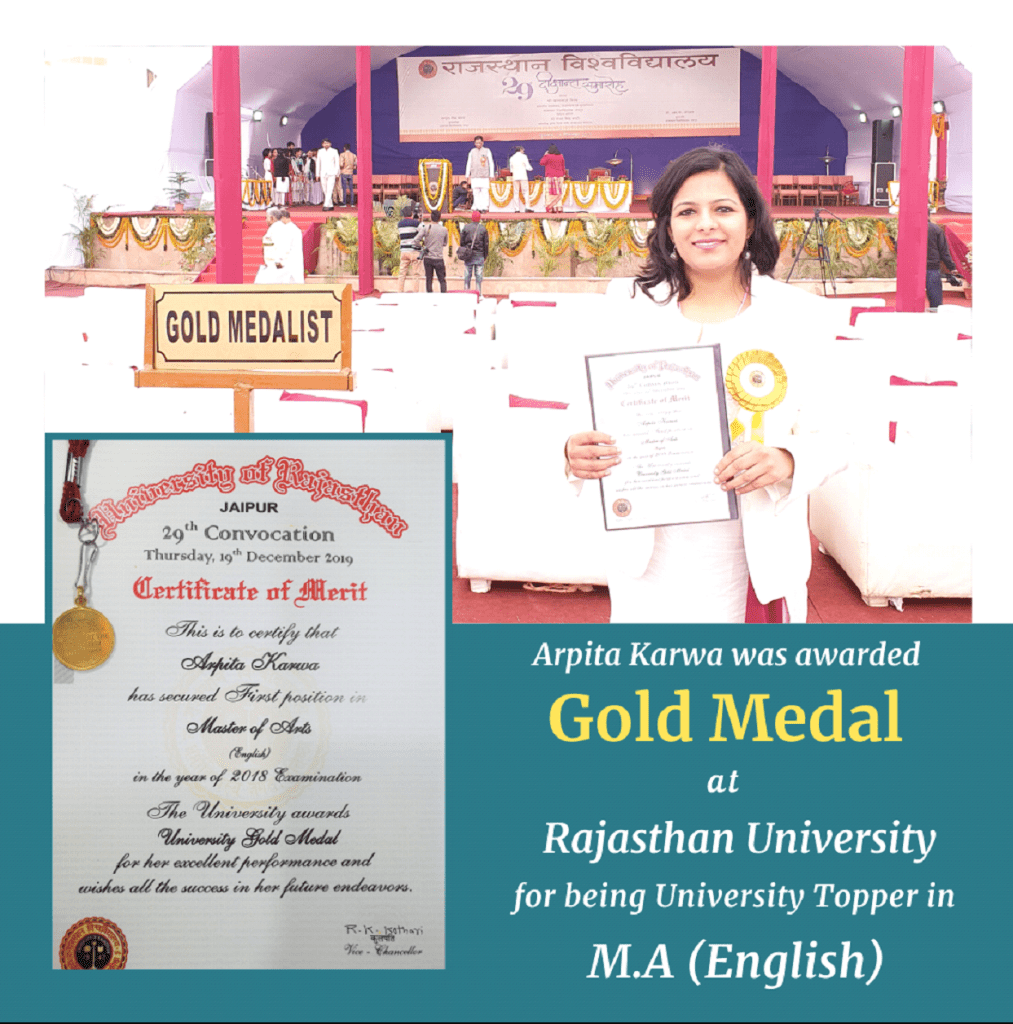March 2023 : Paper 2 (Conduced on 1st March 2023 Morning Shift)
June 19, 2023 2023-12-12 19:13March 2023 : Paper 2 (Conduced on 1st March 2023 Morning Shift)
March 2023 : Paper 2 (Conduced on 1st March 2023 Morning Shift)
Paper 2 (English Literature)
Q.1) “When nature prompted and no law denied Promiscuous use of concubine and bride;
Then Israel’s monarch after Heaven’s own heart,
His vigorous warmth did variously impart
To wives and slaves.”
From which poem are these lines taken?
1) Absalom and Achitophel: A Poem
2) MacFlecknoe
3) A Song for St. Cecilia’s Day
4) Alexander’s Feast
Answer: 1) Absalom and Achitophel: A Poem
Q.2) Which of the following poems is written by Oliver Goldsmith?
1) A Deserted Village
2) A Deserted Villa
3) The Deserted Village
4) A Deserted City
Answer: 3) The Deserted Village
Q.3) Tribute to Papa is a book of poems written by
1) Kamala Das
2) Mamta Kalia
3) Suniti Namjoshi
4) Meena Alexander
Answer: 2) Mamta Kalia
Q.4) Which of the following poems is not written by Sylvia Plath?
1) Lady Lazarus
2) Ariel
3) Daddy
4) To Ariel
Answer: 4) To Ariel
Q.5) Robert Burns was born in
1) Scotland
2) England
3) Ireland
4) America
Answer: 1) Scotland
Q.6) Who among the following characters personifies necessity in P. B Shelley’s Prometheus Unbound?
1) Prometheus
2) Demogorgon
3) Jove
4) Jeus
Answer: 2) Demogorgon
Q.7) Who among the following, after watching the performance of William Shakespeare’s play, A Midsummer Night’s Dream, observed that “it is the most insipid, ridiculous play that I ever saw in my lifE”
1) John Evelyn
2) Samuel Pepys
3) John Dryden
4) Robert Greene
Answer: 2) Samuel Pepys
Q.8) Name the playwright who wrote the play Epicene, or the Silent Woman?
1) William Congreve
2) Thomas Kyd
3) Ben Jonson
4) Thomas Farquhar
Answer: 3) Ben Jonson
Q.9) Abhijnansakuntalam makes use of the following four languages
1) Sanskrit, Shauraseni, Tamil and Maharshtri
2) Sanskrit, Shauraseni, Pali and Oriya
3) Sanskrit, Brajabuli, Maharashtri and Magdhi
4) Sanskrit, Shauraseni, Maharashtri and Magdhi
Answer: 4) Sanskrit, Shauraseni, Maharashtri and Magdhi
Q.10) Choose from the following options the correct combination of playwrights who contributed to the movement called “Kitchen Sink Drama”.
1) John Osborne, Arnold Wesker, Shelagh Delaney and John Arden
2) John Osborne, Arnold Wesker, Harold Pinter and Shelagh Delaney
3) John Osborne, Arnold Wesker, Antonin Artaud and John Arden
4) John Osborne, Harold Pinter, Shelagh Delaney and John Arden
Answer: 1) John Osborne, Arnold Wesker, Shelagh Delaney and John Arden
Q.11) Choose from the following options the correct combination of the plays which made significant use of expressionistic techniques:
1) The Hairy Ape, Machinal, All My Sons, Waiting for Lefty
2) The Hairy Ape, The Crucible, Rapid Transit, The Adding Machine
3) The Hairy Ape, Rapid Transit, All My Sons, The Adding Machine
4) The Hairy Ape, The Emperor Jones, Rapid Transit, The Adding Machine
Answer: 4) The Hairy Ape, The Emperor Jones, Rapid Transit, The Adding Machine
Q.12) Apart from Bertolt Brecht others who have influenced Epic theatre are:
1) Erwin Piscator and Antonin Artaud
2) Martin Esslin and Max Reinhardt
3) Erwin Piscator and Max Reinhardt
4) Constantin Stanislavski and Max Reinhardt
Answer: 3) Erwin Piscator and Max Reinhardt
Q.13) The theological treatise Ecclesiastical Polity was written by
1) Richard Hakluyt
2) Francis Bacon
3) Raphael Holinshed
4) Richard Hooker
Answer: 4) Richard Hooker
Q.14) Who wrote the popular instruction manual for fishermen titled The Compleat Angler, or The Contemplative Man’s Recreation?
1) Isaac Walton
2) Jeremy Taylor
3) Richard Baxter
4) Thomas Hobbes
Answer: 1) Isaac Walton
Q.15) What did Matthew Arnold imply by the term “Hebraism” in his Culture and Anarchy?
1) Moral education
2) Intellectual autonomy
3) Rational outlook
4) Pragmatic attitude
Answer: 1) Moral education
Q.16) The journal Scrutiny was founded in 1932 by
1) I. A) Richards
2) F) R. Leavis
3) Cleanth Brooks
4) John Crowe Ransom
Answer: 2) F R. Leavis
Q.17) Samuel Pepys’ claim to fame rests on his
1) Biography
2) Autobiography
3) Diary
4) Speculative Fiction
Answer: 3) Diary
Q.18) Dr Primrose is a character in
1) Nicholas Nickleby
2) Adam Bede
3) The Vicar of Wakefield
4) Joseph Andrews
Answer: 3) The Vicar of Wakefield
Q.19) “So the baby was carried in a small deal box, under an ancient woman’s shawl, to the churchyard that night, and buried by lantern-light, at the cost of a shilling, and a pint of beer to the sexton, in that shabby corner of God’s allotment where He lets the nettles grow, and where all unbaptized infants, notorious drunkard, suicides and others of the conjecturally damned are laiD)”
From which novel is this excerpt taken?
1) Wuthering Heights by Emily Brontë
2) Tess by Thomas Hardy
3) Great Expectation by Charles Dickens
4) Mill on the Floss by George Eliot
Answer: 2) Tess by Thomas Hardy
Q.20) Which of the following novels is written by Patrick White?
1) Cry, the Beloved Country
2) The Vivisector
3) The Handmaid’s Tale
4) The Stone Angel
Answer: 2) The Vivisector
Q.21) Which among the following is NOT written by Kamala Markandaya?
1) Some Inner Fury
2) The Nowhere Man
3) A Time to be Happy
4) The Golden Honeycomb
Answer: 3) A Time to be Happy
Q.22) Who among the following were revaluing ‘the masses’ as sources and subjects of literature?
1) Richard Hoggart and Raymond Williams
2) Penny Summerfield and Gillian Rose
3) Rachel Alsop and Catherine Belsey
4) Jon Cook and Marilyn Deegan
Answer: 1) Richard Hoggart and Raymond Williams
Q.23) Who among the following theorists has written on narrative empathy?
1) Michael Ryan
2) Suzanne Keane
3) Toni Morrison
4) Sara Ahmed
Answer: 2) Suzanne Keane
Q.24) The science that systematically studies the function of signs is known as
1) Semantics
2) Scriptoria
3) Sismograhpy
4) Semiology
Answer: 4) Semiology
Q.25) Who among the following first framed a theory of general hermeneutics?
1) Wilhelm Dilthey
2) Ferdinand de Saussure
3) Friedrich Schleiermacher
4) E D Hirsch
Answer: 3) Friedrich Schleiermacher
Q.26) Roland Barthes’ Image, Music, Text was published in
1) 1968
2) 1977
3) 1979
4) 1969
Answer: 2) 1977
Q.27) Who among the following distinguished the ‘constatives’ from the ‘performatives’?
1) John Austin
2) Judith Butler
3) Stanley Fish
4) Mary Louise Pratt
Answer: 1) John Austin
Q.28) Who among the following coined the phrase ‘soft capitalism’?
1) Louis Althusser
2) Slavoj Zizek
3) Nigel Thrift
4) Terry Eagleton
Answer: 3) Nigel Thrift
Q.29) To whom is the term ‘thick description’ attributed?
1) John Storey
2) Clifford Geertz
3) Deleuze and Guattari
4) James Clifford
Answer: 2) Clifford Geertz
Q.30) The subject matter of Cultural Studies as it emerged as a ‘proto-discipline’ in the 1960s, was predominantly exploration of
1) High Culture
2) Popular Culture
3) Subaltern History
4) Contemporary Politics
Answer: 2) Popular Culture
Q.31) What does the abbreviated term CCCS stand for in the context of cultural studies?
1) Consortium of Cooperative Culture and Society
2) Conference on Contemporary Culture and Society
3) Centre for Contemporary Cultural Studies
4) Conclave for Collective Consciousness and Socialisation
Answer: 3) Centre for Contemporary Cultural Studies
Q.32) According to Stuart Hall, the concept of played a seminal role in Cultural Studies.
1) Interpellation
2) Dispositive
3) Hegemony
4) Society
Answer: 3) Hegemony
Q.33) The book Political Shakespeare: Essays in Cultural Materialism was jointly edited by
1) Gilles Deleuze and Felix Guattari
2) Alan Sinfield and Jonathan Dollimore
3) Bill Ashcroft and Helen Tiffin
4) Theodor Adorno and Max Horkheimer
Answer: 2) Alan Sinfield and Jonathan Dollimore
Q.34) Identify the work which has NOT been authored by the famous cultural critic Raymond Williams:
1) The Country and the City
2) Culture and Society
3) Modern Tragedy
4) The Making of the English Working Class
Answer: 4) The Making of the English Working Class
Q.35) Second Language is
1) The Language Second In Importance In Terms Of The Use Of Languages By A Learner.
2) The Language Used By A Second-Generation Learner.
3) Any Language Other Than The Learner’s Native Language Or Mother TonguE)
4) The Language Which Is The Learner’s Native Language But Not The Mother TonguE)
Answer: 3) Any Language Other Than The Learner’s Native Language Or Mother TonguE)
Q.36) When a learner’s second language learning system seems to freeze or get stuck at some more or less deviant stage, that phenomenon is known as
1) Freezer
2) Fossilization
3) Language Learning Blockade
4) Language Scaffolding
Answer: 2) Fossilization
Q.37) Integrative motivation refers to
1) Language Learning For Immediate Goals.
2) Language Learning For Practical Goals.
3) Language Learning For Personal Growth And Cultural Enrichment.
4) None Of These
Answer: 3) Language Learning For Personal Growth And Cultural Enrichment.
Q.38) In 1835, which of the following languages was replaced by English as the official language of the East India Company?
1) Sanskrit
2) Persian
3) Arabic
4) Hindi
Answer: 2) Persian
Q.39) Choose the correct option from the following options:
1) The “Magna Carta” of Indian Education in the colonial period refers to “The Missionary Clause 1698”. 2) The “Magna Carta” of Indian Education in the colonial period refers to “Indian Education Commission in 1882”.
3) The “Magna Carta” of Indian Education in the colonial period refers to “Macaulay’s Minute 1835”.
4) The “Magna Carta” of Indian Education in the colonial period refers to “Wood’s Education Despatch of 1854”.
Answer: 4) The “Magna Carta” of Indian Education in the colonial period refers to “Wood’s Education Despatch of 1854”.
Q.40) Which of the following plays of William Shakespeare was translated into Bengali and directed by Girish Chandra Ghosh.
1) The Tempest
2) Hamlet
3) Macbeth
4) King Lear
Answer: 3) Macbeth
Q.41) Which of the following works of Browning are pure dramas?
A) Strafford
B) The Last Ride Together
C) A Blot in the ‘Scutcheon
D) Pippa Passes
E) Porphyria’s Lover
Choose the correct answer from the options given below:
1) A and C
2) B and E
3) C and D
4) B and C
Answer: 1) A and C
Q.42) Who among the following poets have lived in Australia?
A) Judith Wright
B) Yusef Komunyakaa
C) Kath Walker
D) Thomas Kinsella
E) T. S. Eliot
Choose the correct answer from the options given below:
1) A and B
2) A, B and C
3) A, B and D
4) A and E
Answer: 2) A, B and C
Q.43) In An Essay on Criticism, Pope
A) analyses the causes of faulty criticism and praises the great critics of the past. B) analyses the causes of faulty criticism and characterises the good critiC)
C) analyses the structure of a good essay and praises the great critics of the past.
D) analyses the structure of a good essay and suggest how such an essay could be converted into good criticism.
E) analyses the merits of the poetry of Wordsworth and praises the great critics of the past.
Which of the above statements are correct?
1) A and B
2) A, B, and C
3) C, D and E
4) A and D
Answer: 1) A and B
Q.44) Which of the following are plays written by Harold Pinter?
A) Family Voices
B) A Moon for the Misbegotten
C) The Room
D) No Man’s Land
E) Krapp’s Last Tape
Choose the correct answer from the options given below:
1) A, B and E
2) B, C and D
3) A, C and D
4) C, D and E
Answer: 3) A, C and D
Q.45) Which of the following have NOT been written by Mahesh Dattani?
A) Dance Like a Man
B) Fire and the Rain
C) On A Muggy Night in Mumbai
D) A Touch of Brightness
E) Bravely Fought the Queen
Choose the correct answer from the options given below:
1) A and C
2) B and D
3) C and E
4) B and E
Answer: 2) B and D
Q.46) Name the dramas which fall within the category of the Theatre of the AbsurD)
A) The Birthday Party
B) Endgame
C) Mrs. Warren’s Profession
D) The Rhinoceros
E) Riders to the Sea
Choose the correct answer from the options given below:
1) A, B and E
2) B, C and D
3) A, B and D
4) C, D and E
Answer: 3) A, B and D
Q.47) Which of the playwrights have been correctly matched with their works?
A) William Wycherly – The Rivals
B) Ben Jonson – Volpone, or the Fox
C) William Congreve – The Country Wife
D) Aphra Behn – The Dutch Lover
E) Richard Sheridan – A School for Scandal
Choose the correct answer from the options given below:
1) C, D and E
2) B, C and D
3) A, C and E
4) B, D and E
Answer: 4) B, D and E
Q.48) Choose the plays written by Lord Byron
A) Sardanapalus
B) Hellas
C) Cain
D) The Two Foscari: An Historical Tragedy
E) The Cenci
Choose the correct answer from the options given below:
1) A, B and C
2) B, C and E
3) A, B and D
4) A, C and D
Answer: 4) A, C and D
Q.49) John Bunyan authored the following:
A) The Pilgrim’s Progress
B) Grace Abounding
C) Short View
D) The Holy War
E) Thoughts on Education
Choose the correct answer from the options given below:
1) A, B and C
2) A, C and D
3) A, D and E
4) A, B and D
Answer: 4) A, B and D
Q.50) Which of the following works have been authored by Thomas De Quincey?
A) Confessions of An English Opium Eater
B) The French Revolution
C) Hudibras
D) Autobiography
E) Suspiria De Profoundis
Choose the correct answer from the options given below:
1) A, B and C
2) A, C and D
3) A, D and E
4) A, B and D
Answer: 3) A, D and E
Q.51) Which of the following works have been written by Thomas Carlyle?
A) Of Heroes and Hero-Worship
B) The French Revolution
C) Of Human Bondage
D) The Hour and the Man
E) Hudibras
Choose the correct answer from the options given below:
1) A and B
2) A and C
3) A and D
4) A and E
Answer: 1) A and B
Q.52) Which of the following books are written by Julia Kristeva?
A) Desire in Language: A Semiotic Approach to Literature and Art
B) Illuminations
C) Syntax and Semantics
D) La revolution du language poétique
E) The Madwoman in the Attic
Choose the correct answer from the options given below:
1) A and C
2) B and A
3) A and D
4) B and E
Answer: 3) A and D
Q.53) To which of the following theories New Historicism is indebted?
A) Marxism
B) Formalism
C) Reader-response Theory
D) Existentialism
E) Hermeneutics
Choose the correct answer from the options given below:
1) A and C
2) B and A
3) A and E
4) B and C
Answer: 1) A and C
Q.54) Which of the following statements are true about cyberpunk?
A) It is a kind of science fiction.
B) It uses postmodernist techniques and posthumanist themes.
C) Events in this novel usually take place within the virtual reality.
D) It is a kind of fiction written using online platforms.
E) The first cyberpunk was written by Thomas SternE)
Choose the most appropriate answer from the options given below:
1) A, B and D
2) A, C and D
3) A, B and C
4) A, C and E
Answer: 3) A, B and C
Q.55) Identify the correct pairs:
A) Gabriel Garcia Marquez – The Feast of the Goat
B) Jorge Luis Borges – The Autumn of the Patriarch
C) Salman Rushdie – The Enchantress of Florence
D) EL Doctorow – Ragtime
E) A S. Byatt – Possession
Choose the correct answer from the options given below:
1) A, B and C
2) A, B and E
3) B, C and D
4) C, D and E
Answer: 4) C, D and E
Q.56) Which of the following books are written by Aravind Adiga?
A) The Blue Bedspread
B) Between the Assassinations
C) The House of the Blue Mangoes
D) Last Man in Tower
E) The White Tiger
Choose the correct answer from the options given below:
1) A, B and C
2) B, D and E
3) B, C and D
4) A, C and D
Answer: 2) B, D and E
Q.57) Which among the following are correct?
A) JM Coetzee – South Africa
B) Margaret Atwood – Canada
C) Philip Roth – Australia
D) Orhan Pamuk – Turkey
E) Graham Swift – New Zealand
Choose the correct answer from the options given below:
1) A, B and C
2) A, B and D
3) B, C and E
4) B, D and E
Answer: 2) A, B and D
Q.58) Which among the following is correct in the context of R. K Narayan?
A) His The Guide is an open-ended novel.
B) Most of the characters of his novels are from elite section of society.
C) He wrote a short story titled “The Martyr’s Corner.”
D) He received the Booker’s prize for his novel The Vendor of Sweets.
E) Malgudi is a real-life city in KarnatakA)
Choose the correct option given below:
1) A, B, and C
2) A and C
3) A, C and D
4) A, C and E
Answer: 2) A and C
Q.59) Identify the correct pairs:
A) J. C) Ransom – Criticism, InC)
B) William Empson – Seven Types of Ambiguity
C) C) Brooks and R. P. Warren – Understanding Poetry
D) R. P. Blackmur – In Search of the New Criticism
E) Allen Tate – The New Apologists for Poetry
Choose the correct answer from the options given below:
1) A, B and C
2) A, B and D
3) B, C and E
4) B, D and E
Answer: 1) A, B and C
Q.60) Thomas Rymer coined the term ‘poetic justice’ to imply the following:
A) the distribution of earthly rewards and punishments in proportion to the virtue or vice of the various characters
B) literary work governed by decorum and morality
C) literary work guided by random ways things often work out in the actual world
D) the metaphysical nature of poetic experience
E) the justification of poetry to be an integral part of the Ideal republic
Choose the correct answer from the options given below:
1) A and B
2) B and C
3) C and D
4) D and E
Answer: 1) A and B
Q.61) Which among the following are written by Roland Barthes:
A) Allegories of Reading
B) Mythologies
C) The Pleasure of the Text
D) Some Versions of Pastoral
E) What is an Author?
Choose the correct option given below:
1) B and C
2) A and C
3) A, C and D
4) A, C and E
Answer: 1) B and C
Q.62) Which of the following are correctly matched:
A) Jonathan Culler – Culture and Society
B) Raymond Williams – Literary Theory: A Very Short Introduction
C) Terry Eagleton – Criticism and Ideology
D) Walter Benjamin – Illuminations
E) Stanley Fish – The Implied Reader
Choose the correct option:
1) B, C and E
2) C and D
3) A, C and D
4) B, C and D
Answer: 2) C and D
Q.63) Which among the following are true in the context of methods and methodologies in literary research?
A) Both are identical in naturE)
B) Methods are concerned with how one conducts a given piece of research.
C) Methodologies are concerned with how one conducts a given piece of research.
D) Methodologies are concerned with the perspectives one brings to bear on one’s work.
E) Methods are concerned with the perspectives one brings to bear on one’s work.
Choose the correct option:
1) A, D and E
2) B, C and E
3) A and C
4) B and D
Answer: 4) B and D
Q.64) According to the English Subject Centre report, skills needed for postgraduate work in English include
A) Searching skills in libraries
B) Editorial skills
C) Bibliographic skills
D) Peer management skills
E) IT skills
Choose the correct option:
1) A, C and D
2) B, C, D and E
3) A, B and D
4) A, B, C and E
Answer: 3) A, B and D
Q.65) Which of the following are possible ways of turning a topic into an argument?
A) An argument for or against an existing critic (or critical position) in relation to the author or group of works one is studying.
B) An argument about the value of a new theoretical approach to a text or set of texts.
C) An argument about some historical or literary-historical aspect of literaturE)
D) An argument showing how a particular theme or concept is not at all related to a group of texts.
E) An argument about the significance of only well-known author/work.
Choose the correct option:
1) A, B and C
2) B, C, D and E
3) A, C and D
4) A, B, C and D
Answer: 1) A, B and C
Q.66) Match List I with List II
| LIST I | LIST II | ||
|---|---|---|---|
| A) | Sri Aurobindo | I. | Other Poems |
| B) | Kamala Das | II. | Calcutta: A Long Poem |
| C) | P. Lal | III. | A Sheaf Gleaned in French | D) | Toru Dutt | IV. | Savitri |
Choose the correct answer from the options given below:
1) (A)-(III), (B)-(II), (C)-(I), (D)-(IV)
2) (A)-(IV), (B)-(I), (C)-(II), (D)-(III)
3) (A)-(II), (B)-(III), (C)-(IV), (D)-(I)
4) (A)-(II), (B)-(III), (C)-(I), (D)-(IV)
Answer: 2) (A)-(IV), (B)-(I), (C)-(II), (D)-(III)
Q.67) Match List I with List II
| LIST I | LIST II | ||
|---|---|---|---|
| A) | Walt Whitman | I. | Howl |
| B) | A D Hope | II. | A Far Cry From Africa |
| C) | Derek Walcott | III. | Beat! Beat! Drums! |
| D) | Allen Ginsberg | IV. | Australia |
Choose the correct answer from the options given below:
1) (A)-(II), (B)-(III), (C)-(I), (D)-(IV)
2) (A)-(I), (B)-(II), (C)-(III), (D)-(IV)
3) (A)-(III), (B)-(IV), (C)-(II), (D)-(I)
4) (A)-(III), (B)-(II), (C)-(I), (D)-(IV)
Answer: 3) (A)-(III), (B)-(IV), (C)-(II), (D)-(I)
Q.68) Match List I with List II
| LIST I | LIST II | |||
|---|---|---|---|---|
| A) | Come what come may, Time and the hour runs through the roughest day. | I. | Othello | |
| B) | When sorrows come, they come not single spies. But in battalions! | II. | King Lear | |
| C) | I am a man more sinned | against than sinning. | III. | Macbeth |
| D) | But I will wear my heart upon my sleeve For Daws to peck at: I am not what I am. | IV. | Hamlet | |
Choose the correct answer from the options given below:
1) A-IV, B-III, C-II, D-I
2) A-II, B-III, C-I, D-IV
3) A-III, B- IV, C-II, D-I
4) A-I, B-II, C-IV, D-III
Answer: 3) A-III, B- IV, C-II, D-I
Q.69) Match List I with List II
| LIST I | LIST II | ||
|---|---|---|---|
| A) | You can’t eat the orange and throw the peel away- a man is not a piece of fruit. | I. | Man, and Superman |
| B) | Liberty means responsibility. That is why most men dread it. | II. | A Doll’s House |
| C) | Nobody thinks, nobody cares. No beliefs, no convictions and no enthusiasm. Just another Sunday evening. | III. | Death of a Salesman |
| D) | Our home has been nothing but a playroom. I have been your doll-wife, just as at home I was papa’s doll-child; and here the children have been my dolls. | IV. | Look Back in Anger |
Choose the correct answer from the options given below:
1) A-I, B-III, C-II, D-I
2) A-II, B-III, C-IV, D-I
3) A-I, B- IV, C-II, D-III
4) A-III, B-I, C-IV, D-II
Answer: 4) A-III, B-I, C-IV, D-II
Q.70) Match List I with List II
| LIST I | LIST II | ||
|---|---|---|---|
| A) | Anthropology | I. | Edward Soja |
| B) | Postmodern Geography | II. | Martin Heidegger |
| C) | Diaspora Space | III. | Claude Lévi-Strauss |
| D) | Dasein | IV. | Avtar Brah |
Choose the correct answer from the options given below:
1) (A)-(III), (B)-(II), (C)-(I), (D)-(IV)
2) (A)-(IV), (B)-(I), (C)-(II), (D)-(III)
3) (A)-(III), (B)-(I), (C)-(IV), (D)-(II)
4) (A)-(II), (B)-(III), (C)-(I), (D)-(IV)
Answer: 3) (A)-(III), (B)-(I), (C)-(IV), (D)-(II)
Q.71) Match List I with List II
| LIST I | LIST II | ||
|---|---|---|---|
| A) | The Poetics of Prose | I. | Wolfgang Iser |
| B) | Structuralist Poetics | II. | Tzvetan Todorov |
| C) | The Implied Reader | III. | Stanley Fish |
| D) | Is There a Text in This | IV. | Jonathan Culler Class? |
Choose the correct answer from the options given below:
1) (A)-(II), (B)-(III), (C)-(I), (D)-(IV)
2) (A)-(II), (B)-(IV), (C)-(I), (D)-(III)
3) (A)-(III), (B)-(IV), (C)-(II), (D)-(I)
4) (A)-(III), (B)-(II), (C)-(I), (D)-(IV)
Answer: 2) (A)-(II), (B)-(IV), (C)-(I), (D)-(III)
Q.72) Match List I with List II
| LIST I | LIST II | ||
|---|---|---|---|
| A) | Plato | I. | Rhetoric |
| B) | Aristotle | II. | Symposium |
| C) | P. B Shelley | III. | Apology of Poetry |
| D) | Philip Sydney | IV. | Defence of Poetry |
Choose the correct answer from the options given below:
1) A-I, B-II, C-III, DIV
2) A-III, B-II, C-IV, D-I
3) A-IV, B-III, C-II, D – I
4) A-II, B-I, C-IV, D-III
Answer: 4) A-II, B-I, C-IV, D-III
Q.73) Match List I with List II
| LIST I | LIST II | ||
|---|---|---|---|
| A) | Bertrand Russell | I. | The Verbal Icon |
| B) | Thomas Stearns Eliot | II. | The Well Wrought Urn |
| C) | W.K. Wimsatt | III. | History of Western Philosophy |
| D) | Cleanth Brooks | IV. | The Sacred Wood |
Choose the correct answer from the options given below:
1) A-III, B-IV, C-I, D-II
2) A-III, B-I, C-IV, D-II
3) A-III, B-II, C-I, D-IV
4) A-III, B-I, C-II, D-IV
Answer: 1) A-III, B-IV, C-I, D-II
Q.74) Match List I with List II
| LIST I | LIST II | ||
|---|---|---|---|
| A) | “Negative Capability” | I. | Matthew Arnold |
| B) | “Sweetness and light” | II. | Samuel Taylor Coleridge |
| C) | “Esemplastic” | III. | T.S. Eliot |
| D) | “Dissociation of Sensibility” | IV. | John Keats |
Choose the correct answer from the options given below:
1) A-II, B-IV, C-I, D-III
2) A-II, B-I, C-IV, D-III
3) A-IV, B-III, C-II, D-I
4) A-IV, B-I, C-II, D-III
Answer: 4) A-IV, B-I, C-II, D-III
Q.75) Match List I with List II
| LIST I | LIST II | ||
|---|---|---|---|
| A) | Munira | I. | Things Fall Apart |
| B) | Nnu Ego | II. | Petals of Blood |
| C) | Ikemefuna | III. | July’s People |
| D) | Maureen | IV. | The Joys of Motherhood |
Choose the correct answer from the options given below:
1) A-II, B-IV, C-I, D-III
2) A-III, B-II, C-IV, D-I
3) A-IV, B-III, C-II, D-I
4) A-III, B-IV, C-I, D-II
Answer: 1) A-II, B-IV, C-I, D-III
Q.76)Choose the correct chronological sequence in which the following texts were written.
A) Lycidas
B) Hero and Leander
C) Masque of Comus
D) Paradise Lost
E) The Waste Land
1) A, B, D, E, C
2) B, C, A, D, E
3) B, A, E, C, D
4) B, E, D, C, A
Answer: 2) B, C, A, D, E
Q.77) Arrange the following poets in accordance with their years of birth.
A) Rudyard Kipling
B) Robert Browning
C) John Masefield
D) A) E) Housman
E) John Donne
1) E, A, B, D, C
2) E, B, A, C, D
3) E, B, A, D, C
4) A, D, B, C, E
Answer: 3) E, B, A, D, C
Q.78) Arrange the works in chronological sequence:
A) Rajmohan’s Wife
B) A Bend in the Ganges
C) Kanthapura
D) Untouchable
E) Distant Drum
Choose the correct answer from the options given below
1) A, B, C, D, E
2) A, C, D, E, B
3) A, D, C, B, E
4) A, E, D, C, B
Answer: 3) A, D, C, B, E
Q.79) Find the chronological order of publication of Charles Dickens’s novels:
A) Oliver Twist
B) Dombey and Sons
C) Pickwick Papers
D) Bleak House
E) David Copperfield
Choose the correct answer from the options given below
1) A, D, C,
B) E
2) D, E, B,
C) A
3) B, D, C, A, E
4) C, A, B, D, E
Answer: 4) C, A, B, D, E
Q.80) Arrange the works in the chronological order of the staging/ publication of the following plays:
A) A Woman Killed with Kindness
B) John Bull’s Other Island
C) The Double Dealer
D) The Shoemaker’s Holiday
E) The Conscious Lovers
Choose the correct answers from the options given below:
1) B, D, C, A and E
2) D, A, C, E and B
3) C, D, A, B and E
4) E, B, D, C and A
Answer: 2) D, A, C, E and B
Q.81) Arrange the works in chronological sequence:
A) The Theatre of Revolt by Robert Brustein
B) The Theater of the Absurd by Martin Esslin
C) The Playwright as Thinker by Eric Bentley
D) Modern American Drama by C)W.E Bigsby
E) Modern Drama in Theory and Practice by L. N. Styan
Choose the correct answers from the options given below:
1) A, D, C, D and E
2) E, C, D, A and B
3) B, D, A, E and C
4) C, B, A, E and D
Answer: 4) C, B, A, E and D
Q.82) Choose the correct chronological sequence in which the following texts were published:
A) Madness and Civilization
B) The Archaeology of Knowledge
C) The Language of the Self: The Function of Language in Psychoanalysis
D) The Birth of the Clinic
E) Culture and Anarchy
1) E, B, D, C, A
2) E, A, C, B, D
3) E, B, D, A, C
4) C, A, B, D, E
Answer: 2) E, A, C, B, D
Q.83)Choose the correct chronological sequence in which the following theories appeareD)
A) Structuralism
B) Psychoanalysis
C) Ecocriticism
D) Orientalism
E) New Criticism
1) E, B, D, C, A
2) E, A, C, B, D
3) B, E, D, A, C
4) B, E, A, D, C
Answer: 4) B, E, A, D, C
Q.84) Arrange the works in chronological sequence:
A) Matthew Arnold’s Culture and Anarchy
B) Thomas Browne’s The Anatomy of Melancholy
C) Thomas Hobbes’ Leviathan
D) Walter Pater’s Studies in the History of the Renaissance
E) PB Shelley’s Defense of Poesie
Choose the correct answer from the options given below:
1) B, C, E, A, D
2) A, B, C, D, E
3) C, D, E, A, B
4) D, C, B, A, E
Answer: 1) B, C, E, A, D
Q.85) Arrange the works in chronological sequence:
A) Structuralist Poetics
B) Course in General Linguistics
C) The Pursuit of Signs
D) The Pleasure of the Text
E) The Implied Reader
Choose the correct answer from the options given below
1) A, C, D, E, B
2) B, D, E, A, C
3) C, D, A, B, E
4) D, E, A, C, B
Answer: 2) B, D, E, A, C
Q.86) Given below are two statements:
Statement I: The Book The Theatre of Revolt was written by Robert Brustein
Statement II: The Book The Theatre of Revolt is written in the context of French Revolution. In the light of the statements given above choose the correct answer given below:
1) Both Statement I and Statement II are true
2) Both Statement I and Statement II are false
3) Statement I is true and Statement II is false
4) Statement I is false and Statement II is true
Answer: 3) Statement I is true and Statement II is false
Q.87) Given below are two statements:
Statement I: Constantin Stanislavski collaborated with Anton Chekhov to stage dramas on stagE) Statement II: The book My Life in Art was written by Constantin Stanislavski.
In the light of the statements given above choose the correct answer given below:
1) Both Statement I and Statement II are false
2) Both Statement I and Statement II are true
3) Statement I is true and Statement II is false
4) Statement I is false and Statement II is true
Answer: 2) Both Statement I and Statement II are true
Q.88) Given below are two statements:
Statement I: Human bodies, like those of other living organisms, are only ‘sexed’ from a particular narrow perspectivE)
Statement II: Most of the reproductions that we undertake in our lifetimes has nothing to do with ‘sex.’ In the light of the above statements, choose the correct answer given below:
1) Both Statement I and Statement II are truE)
2) Both Statement I and Statement II are falsE)
3) Statement I is true but Statement II is falsE)
4) Statement I is false but Statement II is truE)
Answer: 1) Both Statement I and Statement II are truE)
Q.89) Given below are two statements. One is labelled as Assertion A and the other is labelled as Reason R. Assertion (A): Co-operative learning activities are those in which students must work together in order to complete a task or solve a problem.
Reason (R): These techniques are used to identify a weak learner and to separate him/her from the rest of the members of the group for taking special care of him/her.
In the light of the above statements, choose the most appropriate answer from the option given below:
1) Both (A) and (R) are correct and (R) is the correct explanation of (A).
2) Both (A) and (R) are correct and (R) is not the correct explanation of (A).
3) (A) is correct but (R) is not correct.
4) (A) is not correct but (R) is correct.
Answer: 3) (A) is correct but (R) is not correct.
Q.90) Given below are two statements. One is labelled as Assertion A and the other is labelled as Reason R.
Assertion (A): In second language learning, in the same classroom setting, some students progress rapidly through the initial stages of learning a new language while others struggle making very slow progress. Reason (R): Some learners never achieve native-like command of a second languagE)
In the light of the above statements, choose the most appropriate answer from the option given below:
1) Both (A) and (R) are correct and (R) is the correct explanation of (A).
2) Both (A) and (R) are correct and (R) is not the correct explanation of (A).
3) (A) is correct but (R) is not correct.
4) (A) is not correct but (R) is correct.
Answer: 2) Both (A) and (R) are correct and (R) is not the correct explanation of (A).
Read the following poem and answer the question:
Talking in Bed
Talking in bed ought to be easiest,
Lying together there goes back so far, An emblem of two people being honest.
Yet more and more time passes silently. Outside, the wind’s incomplete unrest Builds and disperses clouds about the sky,
And dark towns heap up on the horizon. None of this cares for us. Nothing shows why At this unique distance from isolation
It becomes still more difficult to find
Words at once true and kind,
Or not untrue and not unkinD)
Philip Larkin
Q.91) Which of the following statements is true?
1) The poet says that talking in bed is very easy.
2) The poet says that talking in bed is not very easy.
3) The poet says that talking in bed should be easy but it is not.
4) The poet says that talking in bed can never be easy.
Answer: 3) The poet says that talking in bed should be easy but it is not.
Q.92) The poet says that when two people are lying together, they look like
1) Two Pure Human Beings.
2) Two Hypocrites.
3) Two Innocent Fellows.
4) None Of These
Answer: 1) Two Pure Human Beings.
Q.93) The poet says that while lying in bed he and his companion pass time
1) By Talking Between Themselves.
2) By Observing The Trees Outside The Window.
3) Silently.
4) By Playing Cards.
Answer: 3) Silently.
Q.94) The poet and his companion are
1) In A Hotel In The Middle Of A Town.
2) In A Room Of A Hotel On The Margin Of The Town.
3) In The Corridor Of A Hotel Far Away From The Towns.
4) In A Place Away From The Towns.
Answer: 4) In A Place Away From The Towns.
Q.95) The poet says that while lying in bed with one’s companion it is difficult to find words which are
1) At Once Honest And Caring
2) At Once True And Unkind
3) At Once Pure And Impure
4) At Once Honest And Touching
Answer: 1) At Once Honest And Caring
Read the following passage and answer the questions that follows:
Poetry in its use of language continually distorts and denies the structure of reality to exalt the structure of the selF) By means of rhyme, assonance or alliteration it couples together words which have no rational connection, that is, no nexus through the world of external reality. It breaks the word up into lines of arbitrary length, cutting across their logical construction. It breaks down their associations, derived from the world of external reality, by means of inversion and every variety of artificial stressing and counterpoint. Thus the world of external reality recedes and the world of instinct, the affective emotional linkage behind the words, becomes the world of reality… In the novel, too, the subjective elements are valued for themselves, and rise to view, but in a different way. The novel blots out external reality by substituting a more or less consistent mock reality which has sufficient ‘stuff’ to stand between the reader and reality. This means that in the novel the emotional associations attach not to words but to the moving current of mock reality symbolised by the words. This is why rhythm, ‘preciousness’, and style are alien to the novel; why the novel translates so well; why novels are not composed of words. They are composed of scenes, actions, stuff, people, just as plays arE)
Q.96) In the above passage, Christopher Caudwell’s statement, “Poetry in its use of language continually distorts and denies the structure of reality to exalt the structure of the self” implies:
1) The pragmatic function of poetry that reflects the social reality through expressive language
2) The capacity of poetry to draw attention to itself as an aesthetic object or artefact
3) Poetry exalts the “structure of the self” by privileging the notion of the ‘egotistical sublime’
4) The mimetic function of poetry that alludes to the world of external reality in simple, clear language
Answer: 2) The capacity of poetry to draw attention to itself as an aesthetic object or artefact
Q.97) What does the word “assonance” mean?
1) Repetition Of Identical Or Similar Consonants
2) Repetition Of Identical Or Similar Vowels
3) Repetition Of Identical Or Similar Phrases
4) Repetition Of Identical Or Similar Clauses
Answer: 2) Repetition Of Identical Or Similar Vowels
Q.98) What does Caudwell imply by the statement: “The novel blots out external reality by substituting a more or less consistent mock reality which has sufficient ‘stuff’ to stand between the reader and reality”?
1) The implication is that the reality of fiction has no existence independent of the words, and our emotional responses are directed by the words
2) The implication is that the reality of fiction is not dependent on the words, and our affective states are not triggered by the words
3) The mock reality subverts the external reality so obtrusively that readers become conscious of the writer’s strategy
4) The novel is different from poetry in the sense that it is metonymic in its mode of linear progression, while poetry is metaphoric relying on subject-privileging
Answer: 1) The implication is that the reality of fiction has no existence independent of the words, and our emotional responses are directed by the words
Q.99) What do you understand by “mock reality” in context of the usage in the above passage?
1) The reality contrived into existence by novelists through strategic use of words
2) The reality evoked through figurative devices
3) The quasi reality effected through the use of poetic devices
4) The reality which is approximate to the external reality
Answer: 1) The reality contrived into existence by novelists through strategic use of words
Q.100) If rhythm, ‘preciousness’, and style are alien to the novel, in which genre are they distinctive features?
1) Drama
2) Poetry
3) Prose
4) Non-fiction
Answer: 2) Poetry






